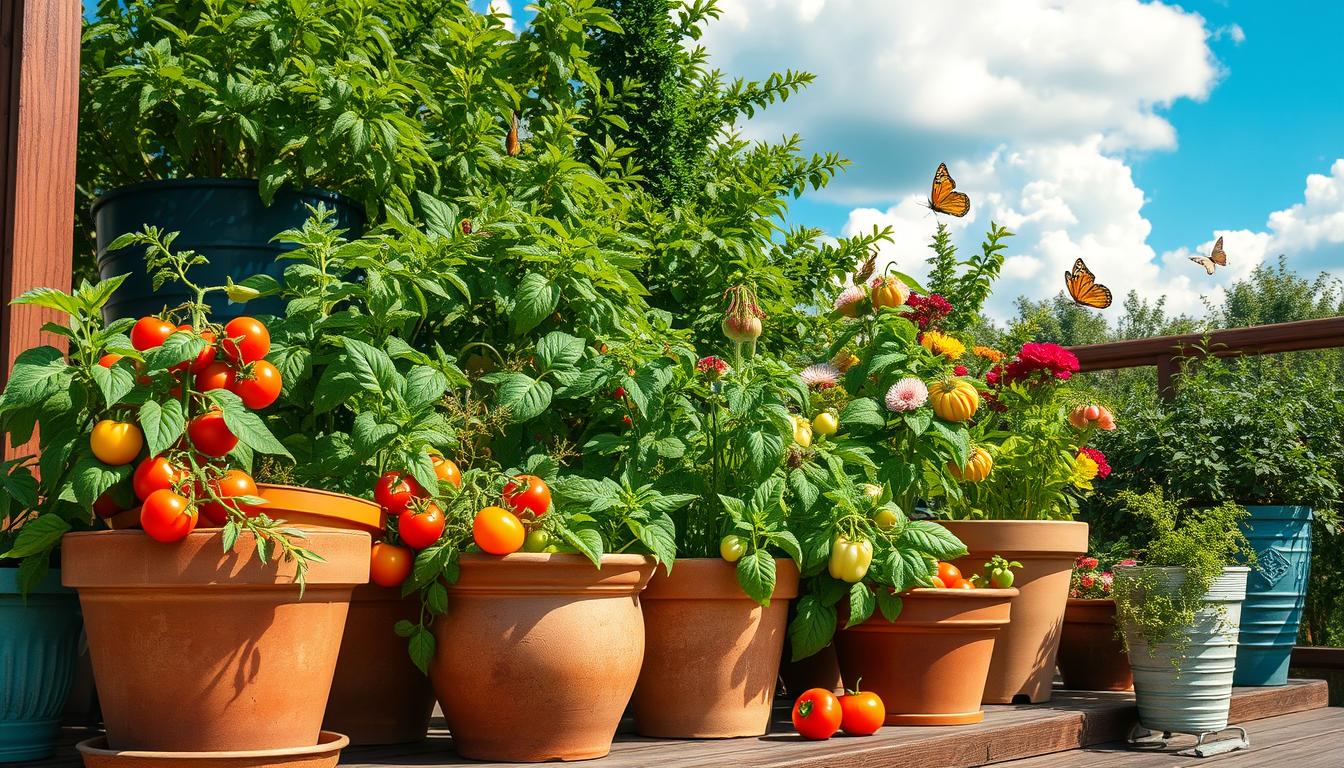Welcome to my guide on growing veggies in pots. It’s perfect for both beginners and experienced gardeners. You’ll learn the basics and advanced techniques for a thriving container garden. I’ll share my knowledge on growing vegetables in pots, from the benefits to the best practices for a great harvest.
Whether you have a small balcony or a big patio, you can grow your favorite veggies in pots. With the right tips and techniques, you’ll enjoy fresh, homegrown produce soon. Container vegetable gardening is fun and rewarding.
Why Grow Vegetables in Pots?
Growing veggies in containers is a great way to garden, even with little space. I’ve found that using potted plants on my balcony lets me enjoy fresh veggies in the city. Starting small with a balcony garden can still lead to a big harvest.
Benefits of Container Gardening
Container gardening lets you control the soil and reduce weeds. It’s also easy to access. This is perfect for those starting small or with limited space.
Ideal for Limited Space
Container gardening is great for city folks or apartment dwellers without a big yard. You can create a lush garden on your balcony, patio, or indoors with pots.
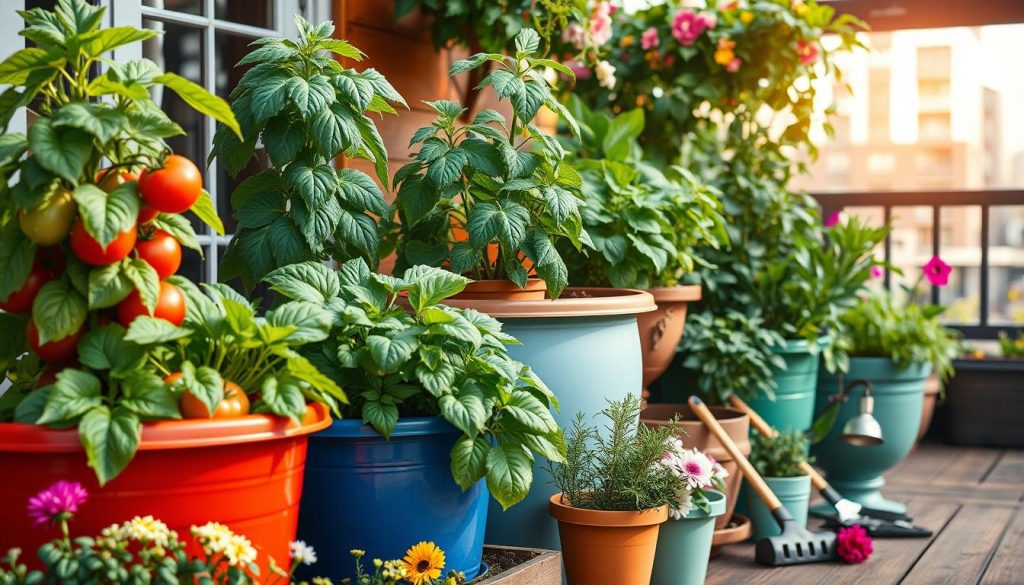
Accessibility and Convenience
One of the best things about container gardening is how easy it is to access and maintain. You can move pots to get the right sunlight and bring them inside when it’s too cold.
Some popular options for container gardening include:
- Using self-watering pots to reduce maintenance
- Creating a trellis system for climbing plants
- Utilizing vertical space with a wall-mounted garden
| Container Size | Vegetable Type | Space Requirements |
|---|---|---|
| Small | Herbs, lettuce | Minimal |
| Medium | Tomatoes, peppers | Moderate |
| Large | Cucumbers, zucchini | Ample |
Choosing the Right Pots
When you start urban container gardening, picking the right pots is key. You’re growing veggies in small spaces, so the pots matter a lot. Think about the material: clay, plastic, or metal. Each has its own good and bad points.
Material Options
Clay pots are loved for being natural and letting air in. Plastic pots are cheaper and light. Metal pots bring a sleek look to your outdoor space.
Size Matters
The size of your pot is super important. A pot that’s too small can hurt your plant’s roots. A pot that’s too big can make the soil too wet. Think about how big your plants will get and how much soil they need.
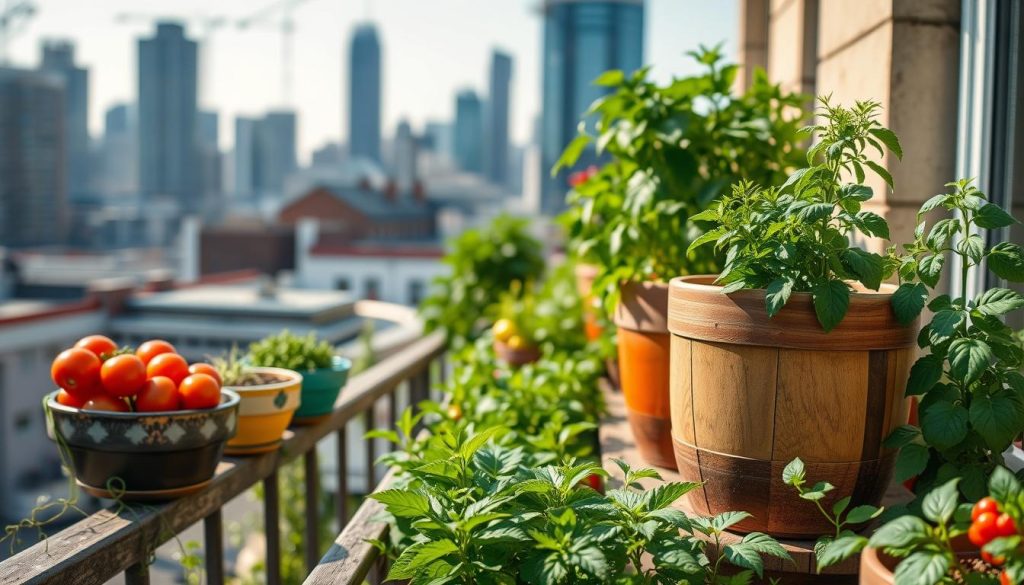
Drainage Considerations
Good drainage is crucial for your plants to thrive. Make sure your pots have enough holes for water to drain. This is key for veggies in pots, as too much water can cause root rot.
Essential Tools for Container Gardening
Learning how to grow vegetables in pots starts with the right tools. As a beginner, investing in basic gardening tools is key. These tools will make your gardening journey easier and more fun. Let’s look at the must-have tools for pot gardening tips and container vegetable gardening.
You’ll need a trowel, watering can, and fertilizer to start. These tools help you prepare the soil, water your plants, and give them nutrients. For instance, a trowel is great for mixing soil and fertilizers. A watering can lets you control how much water your plants get.
Basic Gardening Tools I Recommend
- Trowel
- Watering can
- Fertilizer
Optional Tools for Better Results
There are also optional tools to help you get better results. These include a soil test kit, pruning shears, and a trellis. A soil test kit checks your soil’s pH level. Pruning shears let you trim and shape your plants. A trellis supports climbing plants like peas and beans, keeping them organized.
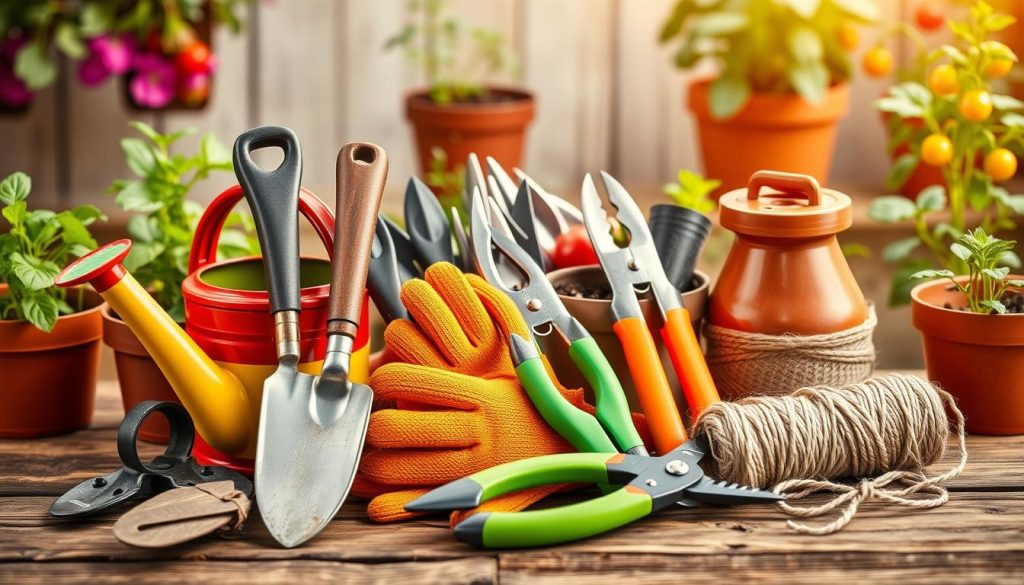
Importance of Quality Soil
Quality soil is vital for healthy plants in container gardening. Choose a potting mix made for containers, with peat moss, vermiculite, and perlite. Don’t use garden soil, as it can compact and block drainage. By following these tips and using the right tools, you’ll grow delicious and healthy vegetables in pots.
Selecting the Right Vegetables
Choosing the right vegetables is key to a successful container garden. Tomatoes, peppers, and herbs do well in pots. They’re great for small spaces like balconies because they need little room and are easy to care for.
When picking vegetables for your container garden, consider a few things:
- Climate: Pick vegetables that fit your local climate and the season.
- Space: Go for compact or dwarf varieties that fit in small containers.
- Light: Choose vegetables that need the same amount of sunlight your garden gets.
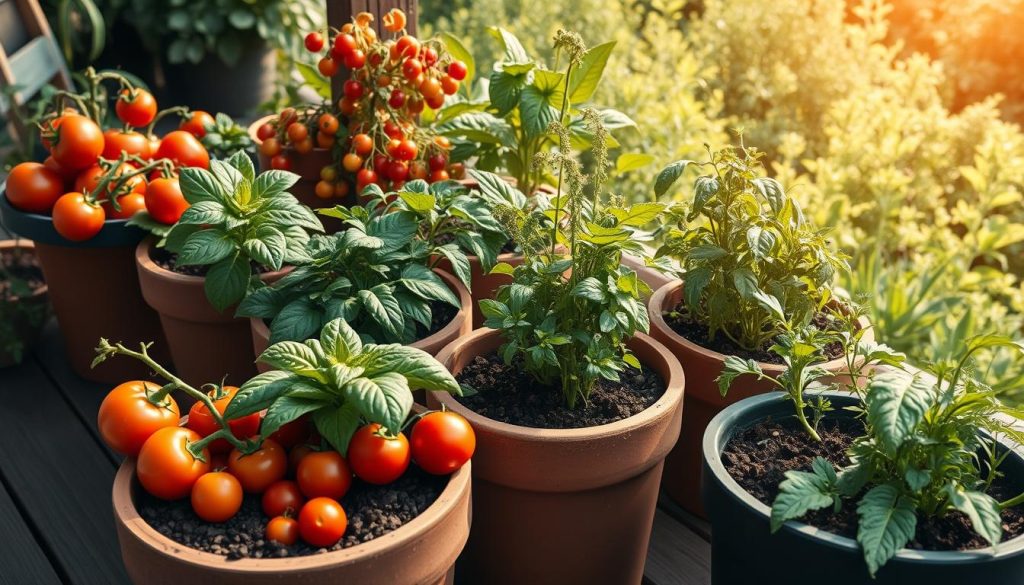
Companion planting in containers can also help. For example, marigolds with tomatoes can keep nematodes away. Basil and mint can make nearby vegetables taste better. By picking the right vegetables and using companion planting, you can have a thriving balcony garden all season.
| Vegetable | Container Size | Light Requirements |
|---|---|---|
| Tomatoes | 12-18 inches | Full sun |
| Peppers | 10-14 inches | Partial shade |
| Herbs | 6-10 inches | Full sun to partial shade |
Soil and Fertilizers
Right soil and fertilizers are key in urban container gardening. They help your plants grow well. If you garden in small spaces, a good potting mix is crucial.
A good mix drains well but holds moisture for plant growth. The mix’s pH level matters too. Different plants need different soil pH levels.
Choosing the Right Potting Mix
Choosing the right mix involves a few things. Think about your plants, your area’s weather, and your containers. These factors help pick the best mix for you.
- The type of plants you are growing
- The climate and weather conditions in your area
- The size and type of containers you are using
Organic vs. Chemical Fertilizers
For fertilizing patio veggies, you can choose organic or chemical options. Organic fertilizers like compost are safe and natural. They’re perfect for small gardens.
Chemical fertilizers work fast but can harm the environment and plants. They’re not the best choice for long-term health.
Watering Techniques for Container Plants
Watering is key in container vegetable gardening. Each veggie needs different amounts of water. Knowing this helps you care for your plants better.
To find the right watering schedule, think about the climate, soil, and veggie needs. Here are some tips:
- Check the soil moisture by sticking your finger into the soil up to the first knuckle.
- Water your plants when the top inch of soil feels dry to the touch.
- Use room-temperature water to avoid shocking the roots.
Understanding Water Needs for Different Vegetables
Some veggies, like tomatoes and cucumbers, need more water. Others, like herbs and lettuce, need less. Knowing this helps you care for each plant better.
Best Practices for Watering
Water your plants in the morning for best absorption. Avoid getting water on leaves to prevent diseases. With these tips, you can water your plants right and enjoy a great harvest.
Sunlight Requirements
Sunlight is key for growing veggies in containers. Most plants need at least 6 hours of direct sunlight daily. If you’re setting up a balcony garden, pick a spot that gets enough sun.
To make sure your plants get even sunlight, rotate your pots often. This helps them grow strong and healthy. It also stops them from leaning or stretching due to uneven sun.
Identifying the Right Spot for Pots
When picking a spot for your pots, think about the sunlight it gets. Watch the area for a few days to find the best spot for your plants.
Shade-Loving Vegetables
Some veggies do well in the shade. Leafy greens like lettuce and kale, and herbs like mint and parsley, are good choices. If your balcony or patio gets partial shade, use containers for these plants.
Knowing what sunlight your plants need helps you grow a great balcony garden. You’ll get fresh, tasty produce all season.
| Vegetable | Sunlight Requirements |
|---|---|
| Lettuce | Partial shade |
| Tomatoes | Full sun |
| Cucumbers | Full sun |
Pest Management in Container Gardens
Urban container gardening is all about keeping pests away. It’s key for a healthy garden, whether it’s in a small space or on a patio. Knowing the common pests that harm plants is crucial.
Pests can spread fast in container gardens. It’s important to check your plants often. Look out for aphids, whiteflies, and spider mites.
Common Pests to Watch For
- Aphids: small, soft-bodied insects that feed on plant sap
- Whiteflies: tiny, winged insects that can transmit diseases
- Spider mites: tiny, spider-like insects that feed on plant sap
Natural Pest Control Methods
Try natural ways to fight pests before using chemicals. Introduce beneficial insects like ladybugs or lacewings. They eat pests. Neem oil is also a natural insecticide for many pests.
When to Use Chemical Solutions
Chemicals might be needed for severe pest problems. But use them carefully and only when necessary. Always follow the instructions and protect yourself, your plants, and the environment.
Supporting Your Plants
As I share my container vegetable gardening experience, I stress the need to support your plants. Each plant has its own needs. For instance, peas and cucumbers need a trellis to climb. Other plants might require stakes for stability.
By following these tips, you can make your container garden thrive. Here are some key points for supporting your plants:
- Trellising: Give climbing veggies like peas and cucumbers a trellis. This helps them grow upwards and saves space.
- Stakes: Use stakes for plants like tomatoes or peppers. They need support to avoid falling over.
- Pruning: Regular pruning keeps your plants healthy and productive. It’s a key part of container gardening.
Using these methods in your gardening routine will help you grow a lot of food. Always look up specific tips for each vegetable you’re growing. Their needs can differ a lot.
Harvesting Your Vegetables
As I walk out to my balcony vegetable garden, I’m always excited to see the progress of my potted vegetable plants. Growing veggies in containers is fun and rewarding, especially when it’s time to harvest. To know if your vegetables are ready, check for signs like color, size, and texture.
For example, tomatoes are ready when they’re fully red and slightly soft when pressed. Cucumbers are ready when they’re dark green and 6-8 inches long. Here are some tips for harvesting different vegetables:
- Leafy greens like lettuce and kale can be harvested as soon as they’re big enough to eat
- Cherry tomatoes can be picked when they’re fully red and ripe
- Carrots should be harvested when they’re between 1/2 and 1 inch in diameter
After harvesting, it’s key to store your produce properly. This keeps it fresh and flavorful. You can store vegetables in a cool, dry place or blanch and freeze them for later. With the right care, your container garden will give you a bountiful harvest all season.
By following these tips, you’ll enjoy the fruits of your labor. Happy harvesting from your balcony garden!
Maintaining Your Container Garden
To keep your container gardening in top shape, you need to do some seasonal upkeep. Start by cleaning and disinfecting your pots at the end of each growing season. This step helps stop plant diseases from spreading and gives your small space vegetable gardening a fresh start for the next year. Also, adding a nutrient-rich potting mix to your patio vegetables in pots revitalizes the soil.
It’s crucial to watch for plant diseases and deal with them quickly. Look for signs of pests or fungal growth on your plants. Use organic pest control or targeted treatments as needed. Taking care of your garden proactively is key to keeping it healthy.
As the growing season ends, prepare your container garden for the next year. Prune any dead or dying leaves, and consider transplanting perennial plants into bigger pots. A bit of TLC at the end of the season ensures your urban container gardening will be ready for a bountiful harvest next spring.

